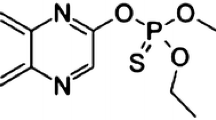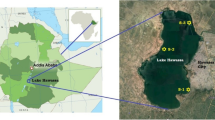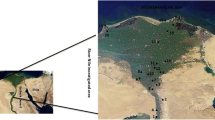Abstract
The application of organophosphorus pesticides (OPPs) increased gradually because of the rise in global food demand that triggered the agriculture sector to increase the production, leading to OPP residues in the surface water. This study elucidated the presence of OPPs and estimated its ecological risk in the riverine ecosystem of the urbanised Linggi River, Negeri Sembilan, Malaysia. The OPP concentration in surface water was determined using solid-phase extraction method and high-performance liquid chromatography coupled with diode array detection. Further, the ecological risk was estimated by using the risk quotient (RQ) method. The three OPPs, i.e. chlorpyrifos, diazinon, and quinalphos were detected with mean concentrations of 0.0275 µg/L, 0.0328 µg/L, and 0.0362 µg/L, respectively. The OPPs were at high risk (in general and worst cases) under acute exposure. The estimated risk of diazinon was observed as medium for general (RQm = 0.5857) and high for worst cases (RQex = 4.4678). Notably, the estimated risk for chlorpyrifos was high for both general and worst cases (RQm = 1.9643 and RQex = 11.5643) towards the aquatic ecosystem of the Linggi River. Chronic risk of quinalphos remains unknown because of the absence of toxicity endpoints. This study presented clear knowledge regarding OPP contamination and possible risk for aquatic ecosystems. Hence, OPPs should be listed as one of the main priority contaminants in pesticide mitigation management in the future.




Similar content being viewed by others
References
Aktar, W., Sengupta, D., & Chowdhury, A. (2009). Impact of pesticides use in agriculture: their benefits and hazards. Interdiscip Toxicol, 2(1), 1–12.
Alexandratos, N., Bruinsma, J. (2012). World agriculture towards 2030/2050: the 2012 revision (vol. 12, no. 3). FAO, Rome: ESA Working paper.
Arias-Estévez, M., López-Periago, E., Martínez-Carballo, E., Simal-Gándara, J., Mejuto, J. C., & García-Río, L. (2008). The mobility and degradation of pesticides in soils and the pollution of groundwater resources. Agriculture, Ecosystems & Environment, 123(4), 247–260.
Campo, J., Masiá, A., Blasco, C., & Picó, Y. (2013). Occurrence and removal efficiency of pesticides in sewage treatment plants of four Mediterranean River Basins. Journal of Hazardous Materials, 263, 146–157.
Carpenter, K. D., Kuivila, K. M., Hladik, M. L., Haluska, T., & Cole, M. B. (2016). Storm-event-transport of urban-use pesticides to streams likely impairs invertebrate assemblages. Environmental Monitoring and Assessment, 188(6), 345.
Casida, J. E., & Durkin, K. A. (2013). Anticholinesterase insecticide retrospective. Chemico-Biological Interactions, 203(1), 221–225.
Ccanccapa, A., Masiá, A., Andreu, V., & Picó, Y. (2016a). Spatio-temporal patterns of pesticide residues in the Turia and Júcar Rivers (Spain). Science of the Total Environment, 540, 200–210.
Ccanccapa, A., Masiá, A., Ortega, A. N., Pico, Y., & Barcelo, D. (2016b). Pesticides in the Ebro River basin: Occurrence and risk assessment. Environmental Pollution, 211, 414–424.
Chen, Y., Yu, K., Hassan, M., Xu, C., Zhang, B., Gin, K. Y. H., et al. (2018). Occurrence, distribution and risk assessment of pesticides in a river-reservoir system. Ecotoxicology and Environmental Safety, 166, 320–327.
Colovic, M. B., Krstic, D. Z., Lazarevic-Pasti, T. D., Bondzic, A. M., & Vasic, V. M. (2013). Acetylcholinesterase inhibitors: Pharmacology and toxicology. Current Neuropharmacology, 11(3), 315–335.
Commission, European. (2003). Technical guidance document on risk assessment: Part II. Belgium: European Commission Joint Research Centre.
Dawson, A. H., Eddleston, M., Senarathna, L., Mohamed, F., Gawarammana, I., Bowe, S. J., et al. (2010). Acute human lethal toxicity of agricultural pesticides: a prospective cohort study. PLoS Medicine, 7(10), e1000357.
Epa, U. S. (2007). Risks of Diazinon Use to the Federally Listed Endangered Barton Springs Salamander (Eurycea sosorum). Washington, DC: United States Environmental Protection Agency.
Fadaei, A., Dehghani, M. H., Nasseri, S., Mahvi, A. H., Rastkari, N., & Shayeghi, M. (2012). Organophosphorous pesticides in surface water of Iran. Bulletin of Environment Contamination and Toxicology, 88(6), 867–869.
FAO. (2017). FOASTAT. Food and Agriculture Organization of the United Nations. Retrieved from http://www.fao.org/faostat/en/.
Fournier, M. L., Echeverría-Sáenz, S., Mena, F., Arias-Andrés, M., de la Cruz, E., & Ruepert, C. (2018). Risk assessment of agriculture impact on the Frío River watershed and Caño Negro Ramsar wetland, Costa Rica. Environmental Science and Pollution Research, 25(14), 13347–13359.
Ghasemzadeh, J., Sinaei, M., & Bolouki, M. (2015). Biochemical and histological changes in fish, spotted scat (Scatophagus argus) exposed to Diazinon. Bulletin of Environment Contamination and Toxicology, 94(2), 164–170.
Gillespie, W., Czapar, G., & Hager, A. (2011). Pesticide fate in the environment: a guide for field inspectors (Contract Report CR 2011-07). Champaign, Illinois: Institute of Natural Resource Sustainability.
Glinski, D. A., Purucker, S. T., Van Meter, R. J., Black, M. C., & Henderson, W. M. (2018). Analysis of pesticides in surface water, stemflow, and throughfall in an agricultural area in South Georgia, USA. Chemosphere, 209, 496–507.
HSDB. (2019). Hazardous substances data bank. Retrieved from https://toxnet.nlm.nih.gov/newtoxnet/hsdb.htm.
Ibrahim, N. K., & Mustafa, F. B. (2010). Spatial and temporal variations of silica in a disturbed tropical river basin. Sains Malaysiana, 39(2), 189–198.
Köck-Schulmeyer, M., Villagrasa, M., de Alda, M. L., Céspedes-Sánchez, R., Ventura, F., & Barceló, D. (2013). Occurrence and behavior of pesticides in wastewater treatment plants and their environmental impact. Science of the Total Environment, 458, 466–476.
Lewis, K. A., Tzilivakis, J., Warner, D. J., & Green, A. (2016). An international database for pesticide risk assessments and management. Human and Ecological Risk Assessment: An International Journal, 22(4), 1050–1064.
Li, D., Huang, Q., Lu, M., Zhang, L., Yang, Z., Zong, M., et al. (2015). The organophosphate insecticide chlorpyrifos confers its genotoxic effects by inducing DNA damage and cell apoptosis. Chemosphere, 135, 387–393.
Liu, W. R., Zhao, J. L., Liu, Y. S., Chen, Z. F., Yang, Y. Y., Zhang, Q. Q., et al. (2015). Biocides in the Yangtze River of China: spatiotemporal distribution, mass load and risk assessment. Environmental Pollution, 200, 53–63.
Montuori, P., Aurino, S., Garzonio, F., Sarnacchiaro, P., Polichetti, S., Nardone, A., et al. (2016). Estimates of Tiber River organophosphate pesticide loads to the Tyrrhenian Sea and ecological risk. Science of the Total Environment, 559, 218–231.
Montuori, P., Aurino, S., Nardone, A., Cirillo, T., & Triassi, M. (2015). Spatial distribution and partitioning of organophosphates pesticide in water and sediment from Sarno River and Estuary, Southern Italy. Environmental Science and Pollution Research, 22(11), 8629–8642.
Müller, K., Bach, M., Hartmann, H., Spiteller, M., & Frede, H. G. (2002). Point-and nonpoint-source pesticide contamination in the Zwester Ohm catchment, Germany. Journal of Environmental Quality, 31(1), 309–318.
Palma, P., Köck-Schulmeyer, M., Alvarenga, P., Ledo, L., Barbosa, I. R., López de Alda, M., et al. (2014). Risk assessment of pesticides detected in surface water of the Alqueva reservoir (Guadiana basin, southern of Portugal). Science of the Total Environment, 488–489, 208–219.
Phillips, P. J., & Bode, R. W. (2002). Concentrations of pesticides and pesticide degradates in the Croton River watershed in southeastern New York, July–September 2000. Reston, Va.: US Department of the Interior, US Geological Survey.
Postigo, C., de Alda, M. J. L., Barceló, D., Ginebreda, A., Garrido, T., & Fraile, J. (2010). Analysis and occurrence of selected medium to highly polar pesticides in groundwater of Catalonia (NE Spain): An approach based on on-line solid phase extraction-liquid chromatography—electrospray-tandem mass spectrometry detection. Journal of Hydrology, 383(1–2), 83–92.
PPDB. (2019). Pesticide properties database. Retrieved from https://sitem.herts.ac.uk/aeru/ppdb/en/atoz.htm.
Sangsawang, A., Kovitvadhi, U., Clearwater, S. J., Kovitvadhi, S., Satapornvanit, K., & Thompson, K. (2017). Acute toxicity of chlorpyrifos and carbosulfan to glochidia of the freshwater mussel Hyriopsis bialata Simpson, 1900. Environmental Science and Pollution Research, 24(26), 21361–21374.
Schaefer, C., Peters, P. W., & Miller, R. K. (2014). Drugs during pregnancy and lactation:Treatment options and risk assessment. In S. M. Barlow, F. M. Sullivan, & R. K. Miller (Eds.), Occupational, industrial and environmental agents. In Drugs During Pregnancy and Lactation (pp. 599–638). Massachusetts: Academic Press.
Stoytcheva, M. (2011). Pesticides in the modern world: Risks and benefits. In V. Chaplain, L. Mamy, L. Vieublé-Gonod, C. Mougin, P. Benoit, E. Barriuso, & S. Nélieu (Eds.), Fate of pesticides in soils: Toward an integrated approach of influential factors (pp. 53–560). London: Intechopen.
Sumon, K. A., Rashid, H., Peeters, E. T., Bosma, R. H., & Van den Brink, P. J. (2018). Environmental monitoring and risk assessment of organophosphate pesticides in aquatic ecosystems of north-west Bangladesh. Chemosphere, 206, 92–100.
Sunanda, M., Rao, J. C. S., Neelima, P., Rao, K. G., & Simhachalam, G. (2016). Effects of chlorpyrifos (an organophosphate pesticide) in fish. International Journal of Pharmaceutical Sciences Review and Research, 39(1), 299–305.
Tang, X., Zhu, B., & Katou, H. (2012). A review of rapid transport of pesticides from sloping farmland to surface waters: Processes and mitigation strategies. Journal of Environmental Sciences, 24(3), 351–361.
Tankiewicz, M., Fenik, J., & Biziuk, M. (2010). Determination of organophosphorus and organonitrogen pesticides in water samples. TrAC Trends in Analytical Chemistry, 29(9), 1050–1063.
US EPA. (2012). Code of federal regulations—priority pollutant. p. 30 (Appendix A to 40 CFR Part 423), United States Environmental Protection Agency, Washington, DC.
Ventura, C., Venturino, A., Miret, N., Randi, A., Rivera, E., Núñez, M., et al. (2015). Chlorpyrifos inhibits cell proliferation through ERK1/2 phosphorylation in breast cancer cell lines. Chemosphere, 120, 343–350.
Villiot, A., Chrétien, E., Drab-Sommesous, E., Rivière, E., Chakir, A., & Roth, E. (2018). Temporal and seasonal variation of atmospheric concentrations of currently used pesticides in Champagne in the centre of Reims from 2012 to 2015. Atmospheric Environment, 174, 82–91.
Walker, W. W. (1978). Insecticide persistence in natural seawater as affected by salinity, temperature, and sterility. Washington, DC: United States Environmental Protection Agency.
Wang, Y., Gao, W., Wang, Y., & Jiang, G. (2019). Suspect screening analysis of the occurrence and removal of micropollutants by GC-QTOF MS during wastewater treatment processes. Journal of Hazardous Materials, 376, 153–159.
Wee, S. Y., & Aris, A. Z. (2017a). Ecological risk estimation of organophosphorus pesticides in riverine ecosystems. Chemosphere, 188, 575–581.
Wee, S. Y., & Aris, A. Z. (2017b). Endocrine disrupting compounds in drinking water supply system and human health risk implication. Environment International, 106, 207–233.
Wee, S. Y., Aris, A. Z., Yusoff, F. M., & Praveena, S. M. (2019). Occurrence and risk assessment of multiclass endocrine disrupting compounds in an urban tropical river and a proposed risk management and monitoring framework. Science of the Total Environment, 671, 431–442.
Wee, S. Y., Omar, T. F. T., Aris, A. Z., & Lee, Y. (2016). Surface water organophosphorus pesticides concentration and distribution in the Langat River, Selangor, Malaysia. Exposure and Health, 8(4), 497–511.
Xing, Y., Yu, Y., & Men, Y. (2018). Emerging investigators series: occurrence and fate of emerging organic contaminants in wastewater treatment plants with an enhanced nitrification step. Environmental Science: Water Research & Technology, 4(10), 1412–1426.
Yashwanth, B., Pamanji, R., & Rao, J. V. (2016). Toxicomorphomics and toxicokinetics of quinalphos on embryonic development of zebrafish (Danio rerio) and its binding affinity towards hatching enzyme, ZHE1. Aquatic Toxicology, 180, 155–163.
Zerin, T., Song, H. Y., & Kim, Y. S. (2015). Quinalphos induced intracellular ROS generation and apoptosis in human alveolar A549 cells. Molecular & Cellular Toxicology, 11(1), 61–69.
Zhang, W. (2018). Global pesticide use: Profile, trend, cost/benefit and more. Proceedings of the International Academy of Ecology and Environmental Sciences, 8(1), 1.
Acknowledgements
This work was supported by Universiti Putra Malaysia (UPM) under Geran Putra [GP/2017/9574800].
Author information
Authors and Affiliations
Corresponding author
Additional information
Publisher's Note
Springer Nature remains neutral with regard to jurisdictional claims in published maps and institutional affiliations.
Electronic supplementary material
Below is the link to the electronic supplementary material.
Rights and permissions
About this article
Cite this article
Zainuddin, A.H., Wee, S.Y. & Aris, A.Z. Occurrence and potential risk of organophosphorus pesticides in urbanised Linggi River, Negeri Sembilan, Malaysia. Environ Geochem Health 42, 3703–3715 (2020). https://doi.org/10.1007/s10653-020-00604-4
Received:
Accepted:
Published:
Issue Date:
DOI: https://doi.org/10.1007/s10653-020-00604-4




